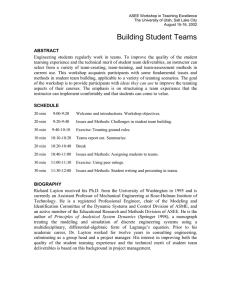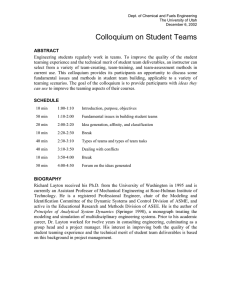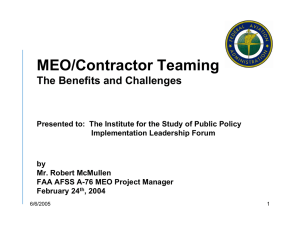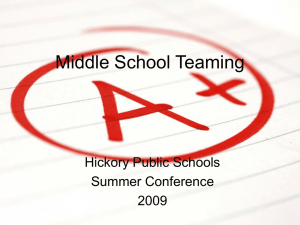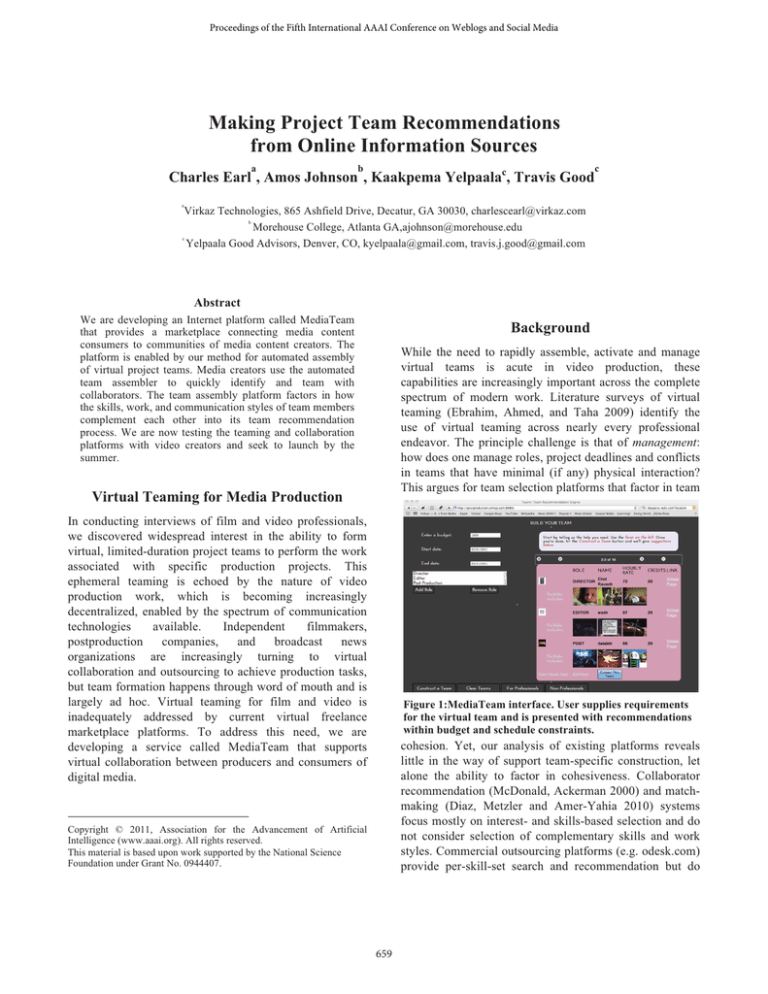
Proceedings of the Fifth International AAAI Conference on Weblogs and Social Media
Making Project Team Recommendations
from Online Information Sources
a
b
c
Charles Earl , Amos Johnson , Kaakpema Yelpaalac, Travis Good
a
Virkaz Technologies, 865 Ashfield Drive, Decatur, GA 30030, charlescearl@virkaz.com
b
Morehouse College, Atlanta GA,ajohnson@morehouse.edu
c
Yelpaala Good Advisors, Denver, CO, kyelpaala@gmail.com, travis.j.good@gmail.com
Abstract
We are developing an Internet platform called MediaTeam
that provides a marketplace connecting media content
consumers to communities of media content creators. The
platform is enabled by our method for automated assembly
of virtual project teams. Media creators use the automated
team assembler to quickly identify and team with
collaborators. The team assembly platform factors in how
the skills, work, and communication styles of team members
complement each other into its team recommendation
process. We are now testing the teaming and collaboration
platforms with video creators and seek to launch by the
summer.
Background
While the need to rapidly assemble, activate and manage
virtual teams is acute in video production, these
capabilities are increasingly important across the complete
spectrum of modern work. Literature surveys of virtual
teaming (Ebrahim, Ahmed, and Taha 2009) identify the
use of virtual teaming across nearly every professional
endeavor. The principle challenge is that of management:
how does one manage roles, project deadlines and conflicts
in teams that have minimal (if any) physical interaction?
This argues for team selection platforms that factor in team
Virtual Teaming for Media Production
In conducting interviews of film and video professionals,
we discovered widespread interest in the ability to form
virtual, limited-duration project teams to perform the work
associated with specific production projects. This
ephemeral teaming is echoed by the nature of video
production work, which is becoming increasingly
decentralized, enabled by the spectrum of communication
technologies
available.
Independent
filmmakers,
postproduction
companies,
and
broadcast
news
organizations are increasingly turning to virtual
collaboration and outsourcing to achieve production tasks,
but team formation happens through word of mouth and is
largely ad hoc. Virtual teaming for film and video is
inadequately addressed by current virtual freelance
marketplace platforms. To address this need, we are
developing a service called MediaTeam that supports
virtual collaboration between producers and consumers of
digital media.
Figure 1:MediaTeam interface. User supplies requirements
for the virtual team and is presented with recommendations
within budget and schedule constraints.
cohesion. Yet, our analysis of existing platforms reveals
little in the way of support team-specific construction, let
alone the ability to factor in cohesiveness. Collaborator
recommendation (McDonald, Ackerman 2000) and matchmaking (Diaz, Metzler and Amer-Yahia 2010) systems
focus mostly on interest- and skills-based selection and do
not consider selection of complementary skills and work
styles. Commercial outsourcing platforms (e.g. odesk.com)
provide per-skill-set search and recommendation but do
Copyright © 2011, Association for the Advancement of Artificial
Intelligence (www.aaai.org). All rights reserved.
This material is based upon work supported by the National Science
Foundation under Grant No. 0944407.
659
not consider cohesion-supporting factors important in the
selection of a team.
The ideal process of virtual team construction should
therefore be one in which an individual wishing to form a
team describes the complementary skills required to
accomplish the team’s goals, provides budget and time
constraints and then submits this description to a system
which returns one or more suggested team configurations,
giving consideration to the skills, communication styles,
and professional experiences best aligned with the goals.
MediaTeam automates this process by running team
construction algorithms upon semantic networks derived
from profession-oriented websites and social networks.
Information sources include task-specific blogs, online
community forums, social networks, member profiles, and
websites that directly describe the skills, work and interests
of potential team members. For each class of data source
document we have developed feature extraction processing
pipelines that produce CCGs. To predict cohesiveness, we
consider several factors among them: communication style
(are the preferred communication modalities of team
members
complementary)
and
trust
reputation
(recommendations attesting to team member reliability).
Multiple capability graphs are merged to produce a
consolidated semantic network describing the complete
span of the knowledge of the team builder of possible team
members.
We cast team construction as determining a perfect
match between the two graphs where all candidate team
members are selected from union of all community
capability graphs. This is bounded by O(V^2*log(V) +
V*E) using Djikstra’s algorithm (Fredman 1987), where
vertices V correspond to members and roles and edges E
correspond to assignments and weighted by scores
computed by member evaluation functions.
By
categorizing the candidate team members by role and
keeping a priority queue for each role class, running time
can be log linear in V.
How It Works
The core technology of virtual team creation is an engine
that creates a semantic network of individuals, their
interests, capabilities, and availabilities from social
network data. This semantic network is called the
Community Capability Graph (CCG), where vertices
correspond to individuals, and edges correspond to
relations and community attributes relevant to expertise.
A media creator seeking a team provides either a
description of the task that they are seeking help with, a
description of the kinds of roles that they need to fill, or the
explicit skills they are seeking. This description is used to
create a set of team roles. These team roles constrain a
search on the CCG; and the result of this search consists of
suggested assignments of team roles to individuals
retrieved from the CCG.
Preliminary Findings
We have evaluated the system using over 5000 profiles
from the vimeo.com and imdb.com sites averaging
milliseconds to provide a seed set consisting of tens of
recommendations.
Figure 2:Structure of the Media Team application. Users
interact through a variety of social media
Next Steps
We are currently expanding the search breadth of the
system and will launch the service shortly.
References
McDonald, D. W. & Ackerman, M. S. (2000). Expertise
recommender: A flexible recommendation system and
architecture. In Proceedings of the 2000 ACM Conference on
Computer Supported Cooperative Work.
Diaz, F., Metzler, D., & Amer-Yahia, S. (2010). Relevance and
ranking in online dating systems. In Proceeding of the 33rd
International ACM SIGIR Conference on Research and
Development in Information Retrieval.
Ebrahim, N. A., Ahmed, S., & Taha, Z. (2009). Virtual R & D
teams in small and medium enterprises: A. Scientific Research
and Essays, 4(13), 1575-1590.
Fredman, M. L. & Tarjan, R. E. (1987). Fibonacci heaps and their
uses in improved network optimization algorithms. Journal of the
ACM (JACM), 34(3), 596-615.
The process of project-team creation is defined in Figure
2. A system administrator provides core information
sources and constructs templates required to describe the
roles and capabilities that a registered user (a team creator)
of the system will use to define project team requirements.
660

